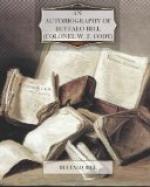There they remained in council a little time and then cantered away single file.
Fearing another trap, the white men remained for weary hours in their hiding-place, but at last were compelled by thirst and hunger to come out.
No Indians were visible, nor did any appear as, worn out and dispirited, they dragged themselves to the camp of the soldiers. In the forty-eight hours since he had been cut off from his command De Rudio had undergone all the horrors of Indian warfare and a hundred times had given himself up for dead.
Bullets had passed many times within a few inches of him. Half a dozen times only a lucky chance had intervened between him and the horrible death that Indians know so well how to inflict. Yet, save for the bruises from his fall off his horse, and the abrasions of the brush through which he had traveled, he had never received a scratch.
CHAPTER XI
Of all the Indians I encountered in my years on the Plains the most resourceful and intelligent, as well as the most dangerous, were the Sioux. They had the courage of dare-devils combined with real strategy. They mastered the white man’s tactics as soon as they had an opportunity to observe them. Incidentally they supplied all thinking and observing white commanders with a great deal that was well worth learning in the art of warfare. The Sioux fought to win, and in a desperate encounter were absolutely reckless of life.
But they also fought wisely, and up to the minute of closing in they conserved their own lives with a vast amount of cleverness. The maxim put into words by the old Confederate fox, Forrest: “Get there fastest with the mostest,” was always a fighting principle with the Sioux.
They were a strong race of men, the braves tall, with finely shaped heads and handsome features. They had poise and dignity and a great deal of pride, and they seldom forgot either a friend or an enemy.
The greatest of all the Sioux in my time, or in any time for that matter, was that wonderful old fighting man, Sitting Bull, whose life will some day be written by a historian who can really give him his due.
Sitting Bull it was who stirred the Indians to the uprising whose climax was the massacre of the Little Big Horn and the destruction of Custer’s command.
For months before this uprising he had been going to and fro among the Sioux and their allies urging a revolt against the encroaching white man. It was easy at that time for the Indians to secure rifles. The Canadian-French traders to the north were only too glad to trade them these weapons for the splendid supplies of furs which the Indians had gathered. Many of these rifles were of excellent construction, and on a number of occasions we discovered to our cost that they outranged the army carbines with which we were equipped.
After the Custer massacre the frontier became decidedly unsafe for Sitting Bull and the chiefs who were associated with him, and he quietly withdrew to Canada, where he was for the time being safe from pursuit.




